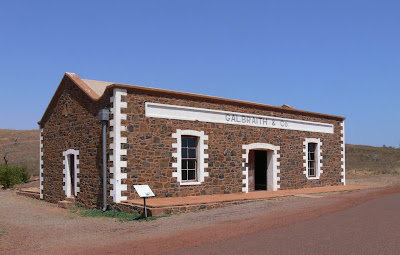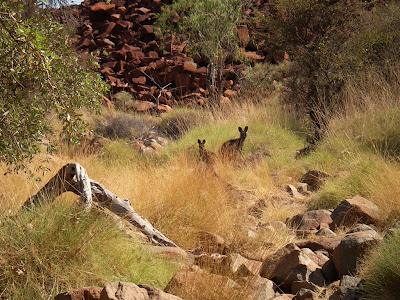It is only about 250 kms from Port Hedland to Karratha, but the road was long and the scenery was unchanging. Here's just a typical view.
.jpg)
About 50 kms before reaching Karratha, we reached Roebourne. It was also the junction leading to Cossack, another town of historic interest on the west-coast. There was no time for a further diversion today, but we promised ourselves a day out to see Cossack.
Roebourne was a significant town in the 1860's with mainly farming interests. In 1872 a cyclone wiped out the old town, but the residents re-built and what we see today is a town of historic stone buildings. Later prosperity came with a gold discovery and in modern times it mining of other minerals. It was a lovely sunny and warm day - not a record here though, in 1998 the town recorded 49.4 degC.!
 A building from the Heritage collection with several artefacts.
A building from the Heritage collection with several artefacts. More from the same site.
More from the same site. The simple church on the hill.
The simple church on the hill..jpg) Finally the impressive Roebourne Post office.
Finally the impressive Roebourne Post office.Having settled into the Karratha camp site, we found that most of our neighbours were not people on holiday or travellers, but contract workers in the mining industry. This had trebled the cost of cabins and changed the ambience of the site.
The next day as promised, we drove to visit Cossack, named after the boat that brought the State Governor to visit the town.
Here in the 1860's the West Australian pearling industry was born and it went through a period of prosperity attracting people from several nationalities, notably Asian because of their pearling/diving experience. A cyclone wiped out the buildings and the pearling fleet in 1881, but undaunted they were back in business shortly after. In 1844 however, the government called a halt to pearling on the grounds of over-fishing, which virtually rang the death knell for the aspiring township and the pearling industry moved to Broome. In 1887 the northwest gold rush started and Cossack was revitalised, stone buildings proliferated and the area was declared a Municipality.

Nanny Goat hill on the left and the stone schoolhouse, built to replace the old wooden structure in 1897.

Above, the Customs House and Bonded Store. Also dating from 1897, it became redundant when the harbour moved to Port Sampson nearby. It then became a cafe, probably associated with the Turtle Soup Factory which operated from another part of the building.
.jpg)
The Post and Telegraph Office was the first stone building to be constructed in Cossack. Built in 1884 it heralded Cossack's own connection to the outside world.

The elegant courthouse dates from 1895 and was little used as the town was by then in slow decline.

Galbraith & Co. bought and sold just about everything in Cossack. Initially sited in a group of wooden buildings, a cyclone put an end to them and the fine edifice seen above was built in 1890.

First landing beach as seen from Tsien Tsin lookout. Tsien Tsin was Cossack's original name - for just a few years.
 Sunset in Karratha.
Sunset in Karratha.
The amazing Sturt Pea. This specimen was spotted by Liz, growing on a splitter island in the centre of town!
 A couple of Galahs impersonating Elvis.
A couple of Galahs impersonating Elvis..jpg) Saltpans on the Karratha-Dampier Road
Saltpans on the Karratha-Dampier Road The massive goods trains taking ore and products in and out of Dampier.
The massive goods trains taking ore and products in and out of Dampier.
At the entrance to Dampier is a statue of "Red Dog", a red kelpie/cattledog well known for roaming the area in the 1970s and hitching rides to nearby towns. The statue reads "Erected by the many friends made during his travels".

The impressive, modern, air-conditioned Gas Shelf Information Centre explains the importance and the functioning of the North West Shelf Venture. It is Australia's largest resource development project and involves the extraction of petroleum (mostly natural gas and condensate) at offshore production platforms, onshore processing and export of liquefied natural gas and production of natural gas for industrial, commercial and domestic use within the state.
A local cultural attraction is the vast collection of ancient aboriginal petroglyphs. Found randomly amongst the rocks of Deep Gorge on the Burrup Peninsula. They have been listed by the Heritage Council of Western Australia, the collection of aboriginal drawings or etchings number over 40,000 individual items.
 These are just a few easily accessible examples that we were able to find.
These are just a few easily accessible examples that we were able to find. A drawing of a kangaroo?
A drawing of a kangaroo? Some real kangaroos. (Actually Euros)
Some real kangaroos. (Actually Euros) We're not sure what this one is.
We're not sure what this one is..jpg) This however is Hearson Cove, a peaceful bay. Spot Liz sitting on the rocks.
This however is Hearson Cove, a peaceful bay. Spot Liz sitting on the rocks.
No comments:
Post a Comment